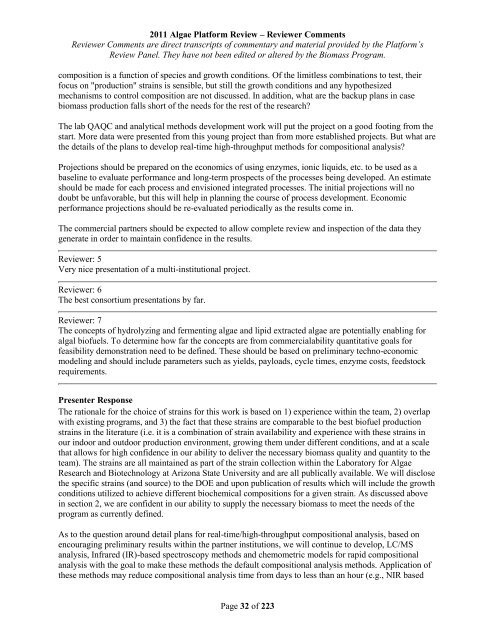Reviewer Comments - EERE
Reviewer Comments - EERE
Reviewer Comments - EERE
You also want an ePaper? Increase the reach of your titles
YUMPU automatically turns print PDFs into web optimized ePapers that Google loves.
2011 Algae Platform Review – <strong>Reviewer</strong> <strong>Comments</strong><br />
<strong>Reviewer</strong> <strong>Comments</strong> are direct transcripts of commentary and material provided by the Platform’s<br />
Review Panel. They have not been edited or altered by the Biomass Program.<br />
composition is a function of species and growth conditions. Of the limitless combinations to test, their<br />
focus on "production" strains is sensible, but still the growth conditions and any hypothesized<br />
mechanisms to control composition are not discussed. In addition, what are the backup plans in case<br />
biomass production falls short of the needs for the rest of the research?<br />
The lab QAQC and analytical methods development work will put the project on a good footing from the<br />
start. More data were presented from this young project than from more established projects. But what are<br />
the details of the plans to develop real-time high-throughput methods for compositional analysis?<br />
Projections should be prepared on the economics of using enzymes, ionic liquids, etc. to be used as a<br />
baseline to evaluate performance and long-term prospects of the processes being developed. An estimate<br />
should be made for each process and envisioned integrated processes. The initial projections will no<br />
doubt be unfavorable, but this will help in planning the course of process development. Economic<br />
performance projections should be re-evaluated periodically as the results come in.<br />
The commercial partners should be expected to allow complete review and inspection of the data they<br />
generate in order to maintain confidence in the results.<br />
<strong>Reviewer</strong>: 5<br />
Very nice presentation of a multi-institutional project.<br />
<strong>Reviewer</strong>: 6<br />
The best consortium presentations by far.<br />
<strong>Reviewer</strong>: 7<br />
The concepts of hydrolyzing and fermenting algae and lipid extracted algae are potentially enabling for<br />
algal biofuels. To determine how far the concepts are from commercialability quantitative goals for<br />
feasibility demonstration need to be defined. These should be based on preliminary techno-economic<br />
modeling and should include parameters such as yields, payloads, cycle times, enzyme costs, feedstock<br />
requirements.<br />
Presenter Response<br />
The rationale for the choice of strains for this work is based on 1) experience within the team, 2) overlap<br />
with existing programs, and 3) the fact that these strains are comparable to the best biofuel production<br />
strains in the literature (i.e. it is a combination of strain availability and experience with these strains in<br />
our indoor and outdoor production environment, growing them under different conditions, and at a scale<br />
that allows for high confidence in our ability to deliver the necessary biomass quality and quantity to the<br />
team). The strains are all maintained as part of the strain collection within the Laboratory for Algae<br />
Research and Biotechnology at Arizona State University and are all publically available. We will disclose<br />
the specific strains (and source) to the DOE and upon publication of results which will include the growth<br />
conditions utilized to achieve different biochemical compositions for a given strain. As discussed above<br />
in section 2, we are confident in our ability to supply the necessary biomass to meet the needs of the<br />
program as currently defined.<br />
As to the question around detail plans for real-time/high-throughput compositional analysis, based on<br />
encouraging preliminary results within the partner institutions, we will continue to develop, LC/MS<br />
analysis, Infrared (IR)-based spectroscopy methods and chemometric models for rapid compositional<br />
analysis with the goal to make these methods the default compositional analysis methods. Application of<br />
these methods may reduce compositional analysis time from days to less than an hour (e.g., NIR based<br />
Page 32 of 223




